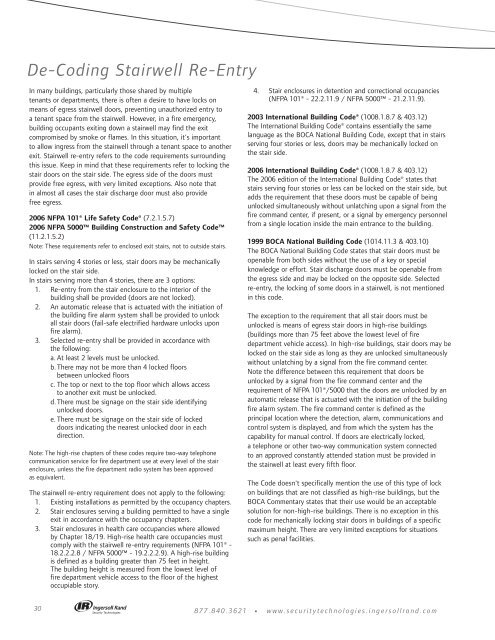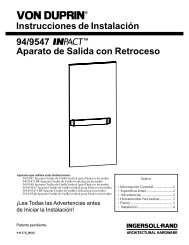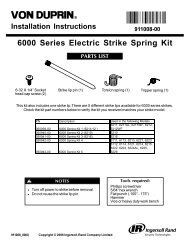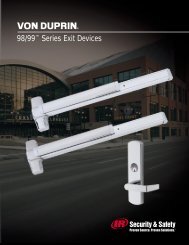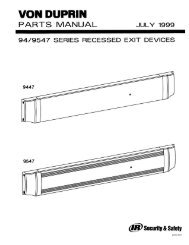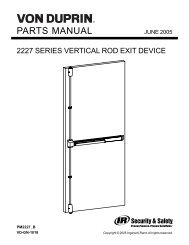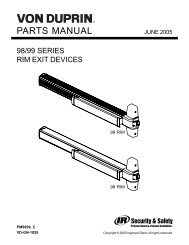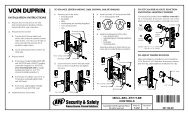Fire, Life Safety & Accessibility Codes - Von Duprin
Fire, Life Safety & Accessibility Codes - Von Duprin
Fire, Life Safety & Accessibility Codes - Von Duprin
Create successful ePaper yourself
Turn your PDF publications into a flip-book with our unique Google optimized e-Paper software.
De-Coding Stairwell Re-Entry<br />
4. Stair enclosures in detention and correctional occupancies<br />
(NFPA 101® - 22.2.11.9 / NFPA 5000 - 21.2.11.9).<br />
In many buildings, particularly those shared by multiple<br />
tenants or departments, there is often a desire to have locks on<br />
means of egress stairwell doors, preventing unauthorized entry to<br />
a tenant space from the stairwell. However, in a fire emergency,<br />
building occupants exiting down a stairwell may find the exit<br />
compromised by smoke or flames. In this situation, it's important<br />
to allow ingress from the stairwell through a tenant space to another<br />
exit. Stairwell re-entry refers to the code requirements surrounding<br />
this issue. Keep in mind that these requirements refer to locking the<br />
stair doors on the stair side. The egress side of the doors must<br />
provide free egress, with very limited exceptions. Also note that<br />
in almost all cases the stair discharge door must also provide<br />
free egress.<br />
2006 NFPA 101® <strong>Life</strong> <strong>Safety</strong> Code® (7.2.1.5.7)<br />
2006 NFPA 5000 Building Construction and <strong>Safety</strong> Code<br />
(11.2.1.5.2)<br />
Note: These requirements refer to enclosed exit stairs, not to outside stairs.<br />
In stairs serving 4 stories or less, stair doors may be mechanically<br />
locked on the stair side.<br />
In stairs serving more than 4 stories, there are 3 options:<br />
1. Re-entry from the stair enclosure to the interior of the<br />
building shall be provided (doors are not locked).<br />
2. An automatic release that is actuated with the initiation of<br />
the building fire alarm system shall be provided to unlock<br />
all stair doors (fail-safe electrified hardware unlocks upon<br />
fire alarm).<br />
3. Selected re-entry shall be provided in accordance with<br />
the following:<br />
a. At least 2 levels must be unlocked.<br />
b.There may not be more than 4 locked floors<br />
between unlocked floors<br />
c. The top or next to the top floor which allows access<br />
to another exit must be unlocked.<br />
d.There must be signage on the stair side identifying<br />
unlocked doors.<br />
e. There must be signage on the stair side of locked<br />
doors indicating the nearest unlocked door in each<br />
direction.<br />
Note: The high-rise chapters of these codes require two-way telephone<br />
communication service for fire department use at every level of the stair<br />
enclosure, unless the fire department radio system has been approved<br />
as equivalent.<br />
The stairwell re-entry requirement does not apply to the following:<br />
1. Existing installations as permitted by the occupancy chapters.<br />
2. Stair enclosures serving a building permitted to have a single<br />
exit in accordance with the occupancy chapters.<br />
3. Stair enclosures in health care occupancies where allowed<br />
by Chapter 18/19. High-rise health care occupancies must<br />
comply with the stairwell re-entry requirements (NFPA 101® -<br />
18.2.2.2.8 / NFPA 5000 - 19.2.2.2.9). A high-rise building<br />
is defined as a building greater than 75 feet in height.<br />
The building height is measured from the lowest level of<br />
fire department vehicle access to the floor of the highest<br />
occupiable story.<br />
2003 International Building Code® (1008.1.8.7 & 403.12)<br />
The International Building Code® contains essentially the same<br />
language as the BOCA National Building Code, except that in stairs<br />
serving four stories or less, doors may be mechanically locked on<br />
the stair side.<br />
2006 International Building Code® (1008.1.8.7 & 403.12)<br />
The 2006 edition of the International Building Code® states that<br />
stairs serving four stories or less can be locked on the stair side, but<br />
adds the requirement that these doors must be capable of being<br />
unlocked simultaneously without unlatching upon a signal from the<br />
fire command center, if present, or a signal by emergency personnel<br />
from a single location inside the main entrance to the building.<br />
1999 BOCA National Building Code (1014.11.3 & 403.10)<br />
The BOCA National Building Code states that stair doors must be<br />
openable from both sides without the use of a key or special<br />
knowledge or effort. Stair discharge doors must be openable from<br />
the egress side and may be locked on the opposite side. Selected<br />
re-entry, the locking of some doors in a stairwell, is not mentioned<br />
in this code.<br />
The exception to the requirement that all stair doors must be<br />
unlocked is means of egress stair doors in high-rise buildings<br />
(buildings more than 75 feet above the lowest level of fire<br />
department vehicle access). In high-rise buildings, stair doors may be<br />
locked on the stair side as long as they are unlocked simultaneously<br />
without unlatching by a signal from the fire command center.<br />
Note the difference between this requirement that doors be<br />
unlocked by a signal from the fire command center and the<br />
requirement of NFPA 101®/5000 that the doors are unlocked by an<br />
automatic release that is actuated with the initiation of the building<br />
fire alarm system. The fire command center is defined as the<br />
principal location where the detection, alarm, communications and<br />
control system is displayed, and from which the system has the<br />
capability for manual control. If doors are electrically locked,<br />
a telephone or other two-way communication system connected<br />
to an approved constantly attended station must be provided in<br />
the stairwell at least every fifth floor.<br />
The Code doesn't specifically mention the use of this type of lock<br />
on buildings that are not classified as high-rise buildings, but the<br />
BOCA Commentary states that their use would be an acceptable<br />
solution for non-high-rise buildings. There is no exception in this<br />
code for mechanically locking stair doors in buildings of a specific<br />
maximum height. There are very limited exceptions for situations<br />
such as penal facilities.<br />
30 877.840.3621 • www.securitytechnologies.ingersollrand.com


